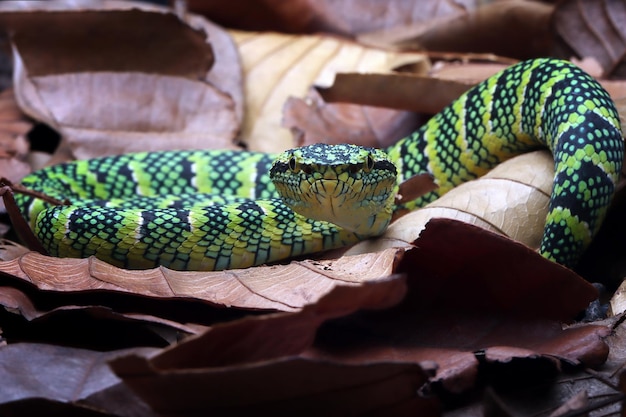Facts about King Cobras – The World’s Longest Venomous Snake

King cobras are the world’s largest venomous snakes, reaching lengths of up to 18 feet.
These majestic snakes are native to Southeast Asia, primarily found in India and Southeast Asian countries.
King cobras are famous for their distinctive hoods, which they expand when they feel threatened or agitated.
Unlike most other snakes, king cobras can actually lift about a third of their bodies off the ground.
The venom of a king cobra is extremely potent and can kill an elephant in a matter of hours.
Despite their deadly reputation, king cobras are generally shy and will often flee from humans rather than attack.
King cobras have a life span of about 20 years in the wild, but can live up to 30 years in captivity.
These snakes are solitary creatures, only coming together during mating season.
King cobras have excellent eyesight and can track their prey from a distance.
Their diet primarily consists of other snakes, including venomous ones such as pythons and even other king cobras.
King cobras are not true cobras, but they are part of the same family, Elapidae.
The scientific name of a king cobra is Ophiophagus hannah, which means snake-eating snake.
In addition to their eyesight, king cobras also have excellent hearing and can sense vibrations in the ground.
These snakes are known for their impressive speed, capable of moving at speeds of up to 12 miles per hour.
King cobras are oviparous, meaning they lay eggs, and the female can lay between 20-50 eggs at a time.
Facts about King Cobras – The World’s Longest Venomous Snake part 2
The female king cobra builds a nest for her eggs and fiercely guards them until they hatch, sacrificing herself if necessary.
The venom of a king cobra attacks the nervous system of its prey, causing paralysis and eventual death.
King cobras are often associated with Indian mythology and are considered sacred by some cultures.
These snakes have been featured in many movies and are often portrayed as deadly and fearsome creatures.
King cobras play an important role in balancing ecosystems by controlling the population of other snakes.
The average length of a king cobra is around 13-15 feet, although some individuals have been recorded to reach even longer lengths.
King cobras are excellent swimmers and can stay underwater for up to 30 minutes.
These snakes are capable of standing up and raising the front portion of their bodies when they feel threatened.
King cobras are also known for their ability to strike at a person’s chest level, unlike most other snakes that strike at ankle level.
The venom of a king cobra is a neurotoxin that affects the nervous system and can cause a variety of symptoms, including paralysis and respiratory failure.
King cobras are an important symbol in traditional medicine in Southeast Asia and their various body parts are believed to have healing properties.
The bite of a king cobra can deliver a large amount of venom in a single bite, making it particularly dangerous.
The venom of a king cobra is being studied for potential medical uses, including the development of new painkillers.
Despite their deadly reputation, king cobras are important for maintaining the health of their ecosystems by controlling rodent populations.
King cobras have unique scales on their belly that help them grip and climb trees easily.
These snakes have heat-sensing pits on their snouts that allow them to detect the body heat of their prey.
King cobras are not limited to jungles and can be found in a range of habitats, including grasslands and bamboo forests.
The mating rituals of king cobras can be elaborate, and the male will dance and sway to attract a female.
Recent studies have found that king cobras possess a genetic adaptation that allows them to metabolize venom faster, providing a potential avenue for developing new antidotes.
King cobras have a highly developed forked tongue, which they use to collect scent particles from the air and transfer them to a sensory organ in their mouths.
These snakes are sensitive to loud noises and sudden movements, which can trigger defensive behavior.
The venom of a king cobra affects the cardiovascular system, causing a drop in blood pressure and potentially leading to cardiac arrest.
King cobras shed their skin regularly to accommodate their growth, with younger snakes shedding more frequently than adults.
These snakes have a strong sense of territoriality and will defend their area from other snakes, including other king cobras.
King cobras are popular attractions in zoos around the world due to their striking appearance and deadly reputation.
The venom of a king cobra can be used to create antivenom, which is essential for treating snakebite victims.
The geographic range of king cobras is shrinking due to habitat destruction and hunting for their skin and body parts, leading to their designation as a vulnerable species.
King cobras are ectothermic, meaning they rely on external sources of heat to regulate their body temperature.
Despite their venomous nature, king cobras are considered sacred in some cultures and can be encountered in religious ceremonies.
King cobras are fascinating creatures that have captured the imagination of people around the world, symbolizing power, danger, and beauty.

